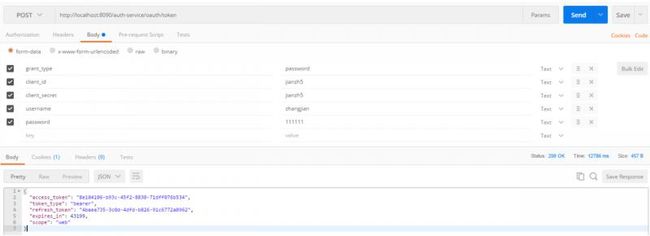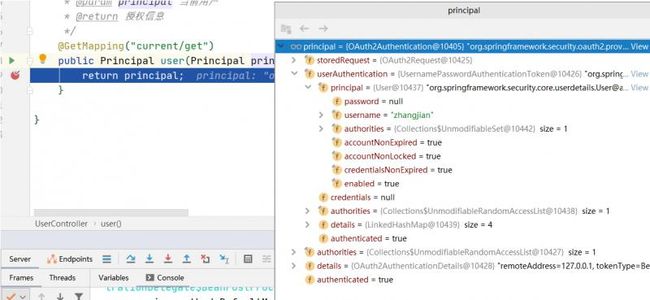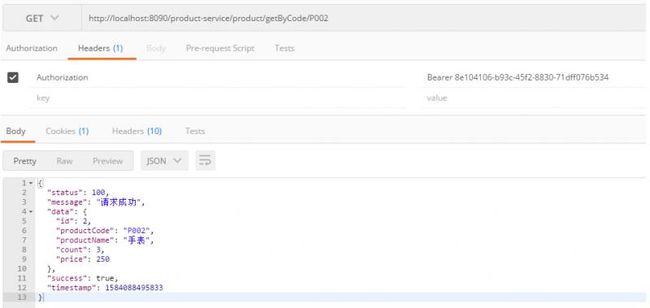SpringCloud Alibaba微服务实战十四 - SpringCloud Gateway集成Oauth2.0
导读:上篇文章我们已经抽取出了单独的认证服务,本章主要内容是让SpringCloud Gateway 集成Oauth2。
概念部分
在网关集成Oauth2.0后,我们的流程架构如上。主要逻辑如下:
1、客户端应用通过api网关请求认证服务器获取access_token http://localhost:8090/auth-service/oauth/token
2、认证服务器返回access_token
{
"access_token": "f938d0c1-9633-460d-acdd-f0693a6b5f4c",
"token_type": "bearer",
"refresh_token": "4baea735-3c0d-4dfd-b826-91c6772a0962",
"expires_in": 43199,
"scope": "web"
}
3、客户端携带access_token通过API网关访问后端服务

4、API网关收到access_token后通过 AuthenticationWebFilter 对access_token认证
5、API网关转发后端请求,后端服务请求Oauth2认证服务器获取当前用户
在前面文章中我们搭建好了单独的Oauth2认证授权服务,基本功能框架都实现了,这次主要是来实现第四条,SpringCloud 整合 Oauth2 后如何进行access_token过滤校验。
代码示例
引入组件
>
>org.springframework.boot >
>spring-boot-starter-security >
>
>
>org.springframework.security >
>spring-security-oauth2-resource-server >
>
>
>org.springframework.cloud >
>spring-cloud-starter-oauth2 >
>
>
>org.springframework.boot >
>spring-boot-starter-jdbc >
>
>
>mysql >
>mysql-connector-java >
>
主要引入跟oauth2相关的jar包,这里还需要引入数据库相关的jar包,因为我们的token是存在数据库中,要想在网关层校验token的有效性必须先从数据库取出token。
bootstrap.yml 配置修改
spring:
application:
name: cloud-gateway
datasource:
type: com.zaxxer.hikari.HikariDataSource
url: jdbc:mysql://xx.0.xx.xx:3306/oauth2_config?characterEncoding=utf8&zeroDateTimeBehavior=convertToNull&useSSL=false
username: xxxxx
password: xxxxxxx
driver-class-name: com.mysql.jdbc.Driver
主要配置oauth2的数据库连接地址
自定义认证接口管理类
在webFlux环境下通过实现 ReactiveAuthenticationManager 接口 自定义认证接口管理,由于我们的token是存在jdbc中所以命名上就叫ReactiveJdbcAuthenticationManager
@Slf4j
public class ReactiveJdbcAuthenticationManager implements ReactiveAuthenticationManager {
private TokenStore tokenStore;
public JdbcAuthenticationManager(TokenStore tokenStore){
this.tokenStore = tokenStore;
}
@Override
public Mono<Authentication> authenticate(Authentication authentication) {
return Mono.justOrEmpty(authentication)
.filter(a -> a instanceof BearerTokenAuthenticationToken)
.cast(BearerTokenAuthenticationToken.class)
.map(BearerTokenAuthenticationToken::getToken)
.flatMap((accessToken ->{
log.info("accessToken is :{}",accessToken);
OAuth2AccessToken oAuth2AccessToken = this.tokenStore.readAccessToken(accessToken);
//根据access_token从数据库获取不到OAuth2AccessToken
if(oAuth2AccessToken == null){
return Mono.error(new InvalidTokenException("invalid access token,please check"));
}else if(oAuth2AccessToken.isExpired()){
return Mono.error(new InvalidTokenException("access token has expired,please reacquire token"));
}
OAuth2Authentication oAuth2Authentication =this.tokenStore.readAuthentication(accessToken);
if(oAuth2Authentication == null){
return Mono.error(new InvalidTokenException("Access Token 无效!"));
}else {
return Mono.just(oAuth2Authentication);
}
})).cast(Authentication.class);
}
}
网关层的安全配置
@Configuration
public class SecurityConfig {
private static final String MAX_AGE = "18000L";
@Autowired
private DataSource dataSource;
@Autowired
private AccessManager accessManager;
/**
* 跨域配置
*/
public WebFilter corsFilter() {
return (ServerWebExchange ctx, WebFilterChain chain) -> {
ServerHttpRequest request = ctx.getRequest();
if (CorsUtils.isCorsRequest(request)) {
HttpHeaders requestHeaders = request.getHeaders();
ServerHttpResponse response = ctx.getResponse();
HttpMethod requestMethod = requestHeaders.getAccessControlRequestMethod();
HttpHeaders headers = response.getHeaders();
headers.add(HttpHeaders.ACCESS_CONTROL_ALLOW_ORIGIN, requestHeaders.getOrigin());
headers.addAll(HttpHeaders.ACCESS_CONTROL_ALLOW_HEADERS, requestHeaders.getAccessControlRequestHeaders());
if (requestMethod != null) {
headers.add(HttpHeaders.ACCESS_CONTROL_ALLOW_METHODS, requestMethod.name());
}
headers.add(HttpHeaders.ACCESS_CONTROL_ALLOW_CREDENTIALS, "true");
headers.add(HttpHeaders.ACCESS_CONTROL_EXPOSE_HEADERS, "*");
headers.add(HttpHeaders.ACCESS_CONTROL_MAX_AGE, MAX_AGE);
if (request.getMethod() == HttpMethod.OPTIONS) {
response.setStatusCode(HttpStatus.OK);
return Mono.empty();
}
}
return chain.filter(ctx);
};
}
@Bean
SecurityWebFilterChain webFluxSecurityFilterChain(ServerHttpSecurity http) throws Exception{
//token管理器
ReactiveAuthenticationManager tokenAuthenticationManager = new ReactiveJdbcAuthenticationManager(new JdbcTokenStore(dataSource));
//认证过滤器
AuthenticationWebFilter authenticationWebFilter = new AuthenticationWebFilter(tokenAuthenticationManager);
authenticationWebFilter.setServerAuthenticationConverter(new ServerBearerTokenAuthenticationConverter());
http
.httpBasic().disable()
.csrf().disable()
.authorizeExchange()
.pathMatchers(HttpMethod.OPTIONS).permitAll()
.anyExchange().access(accessManager)
.and()
// 跨域过滤器
.addFilterAt(corsFilter(), SecurityWebFiltersOrder.CORS)
//oauth2认证过滤器
.addFilterAt(authenticationWebFilter, SecurityWebFiltersOrder.AUTHENTICATION);
return http.build();
}
}
这个类是SpringCloug Gateway 与 Oauth2整合的关键,通过构建认证过滤器 AuthenticationWebFilter 完成Oauth2.0的token校验。
AuthenticationWebFilter 通过我们自定义的 ReactiveJdbcAuthenticationManager 完成token校验。
我们在这里还加入了CORS过滤器,以及权限管理器 AccessManager
权限管理器
@Slf4j
@Component
public class AccessManager implements ReactiveAuthorizationManager<AuthorizationContext> {
private Set<String> permitAll = new ConcurrentHashSet<>();
private static final AntPathMatcher antPathMatcher = new AntPathMatcher();
public AccessManager (){
permitAll.add("/");
permitAll.add("/error");
permitAll.add("/favicon.ico");
permitAll.add("/**/v2/api-docs/**");
permitAll.add("/**/swagger-resources/**");
permitAll.add("/webjars/**");
permitAll.add("/doc.html");
permitAll.add("/swagger-ui.html");
permitAll.add("/**/oauth/**");
permitAll.add("/**/current/get");
}
/**
* 实现权限验证判断
*/
@Override
public Mono<AuthorizationDecision> check(Mono<Authentication> authenticationMono, AuthorizationContext authorizationContext) {
ServerWebExchange exchange = authorizationContext.getExchange();
//请求资源
String requestPath = exchange.getRequest().getURI().getPath();
// 是否直接放行
if (permitAll(requestPath)) {
return Mono.just(new AuthorizationDecision(true));
}
return authenticationMono.map(auth -> {
return new AuthorizationDecision(checkAuthorities(exchange, auth, requestPath));
}).defaultIfEmpty(new AuthorizationDecision(false));
}
/**
* 校验是否属于静态资源
* @param requestPath 请求路径
* @return
*/
private boolean permitAll(String requestPath) {
return permitAll.stream()
.filter(r -> antPathMatcher.match(r, requestPath)).findFirst().isPresent();
}
//权限校验
private boolean checkAuthorities(ServerWebExchange exchange, Authentication auth, String requestPath) {
if(auth instanceof OAuth2Authentication){
OAuth2Authentication athentication = (OAuth2Authentication) auth;
String clientId = athentication.getOAuth2Request().getClientId();
log.info("clientId is {}",clientId);
}
Object principal = auth.getPrincipal();
log.info("用户信息:{}",principal.toString());
return true;
}
}
主要是过滤掉静态资源,将来一些接口权限校验也可以放在这里。
测试
总结
通过以上几步我们将SpringCloud Gateway整合好了Oauth2.0,这样我们整个项目也基本完成了,后面几期再来对项目进行优化,欢迎持续关注。
SpringCloud Alibaba 系列文章
- SpringCloud Alibaba微服务实战系列








